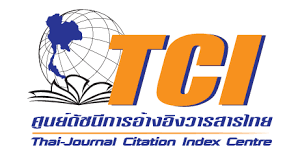FACTORS AFFECTING TO THAI TOURIST DECISION MAKING OF THE MILLENNIAL AFTER THE RELAXATION OF PREVENTIVE MEASURES FOR COVID 19
Keywords:
push factor, pull factor, decision making on traveling, the millennialAbstract
This research aims to study (1) Push factors pull factors and decision process (2) Push factors affecting to Thai tourist decision making (3) Pull factors affecting to Thai tourist decision making of the Millennial after the relaxation of preventive measures for COVID 19. The methodology is quantitative research, online questionnaires distributed to 385 sample millennials. Data were analyzed with descriptive statistics (percentage mean standard deviation), and multiple regression. The results showed that (1) The level of opinion on the push factor were at the high level (2) The level of opinion on the pull factor were at the high level (3) The level of opinion on the push decision process were at the high level (4) Push factors affecting Thai tourist decision making of the Millennial after the relaxation of preventive measures for COVID 19 with statistical significance at the 0.01 level include Social Need Novelty Needs Physiological Need and Culture Needs and (5) Pull factors affecting Thai tourist decision making of the Millennial after the relaxation of preventive measures for COVID 19 with statistical significance at the 0.01 level include Product Price and Place. As a result, the tourism department should prioritize of design and develop the tourism product, set the suitable price of tourism and create the variables of the channel of distribution (place) for motivate the traveling of the millennial.
References
กองเศรษฐกิจการท่องเที่ยวและกีฬา. (2563). สถานการณ์การท่องเที่ยวเดือนธันวาคม 2563. สืบค้นเมื่อ 20 สิงหาคม 2565, จาก https://www.mots.go.th/download/article/article_20210217155048.pdf
กัญญารัตน์ บุญนำ. (2565). ปัจจัยที่ส่งผลต่อการตัดสินใจท่องเที่ยวพิพิธภัณฑ์รอบเกาะรัตนโกสินทร์ กรณีศึกษาคนเจเนอเรชัน Y. วารสารสวนสุนันทาวิชาการและวิจัย, 16(2), 44-59. https://so05.tci-thaijo.org/index.php/ssajournal/article/view/257567
ฉัตรชัย อินทสังข์ และ ดุษฎี เทียมเทศ บุญมาทรงสูง. (2562). การศึกษาพฤติกรรมและการตัดสินใจของนักท่องเที่ยวเชิงชุมชน กลุ่มมิลเลนเนียล: กรณีของบ้านด่านเกวียน จังหวัดนครราชสีมา. วารสารศิลปศาสตร์และวิทยาการจัดการ มหาวิทยาลัยเกษตรศาสตร์, 6(1), 1-12. https://kuojs.lib.ku.ac.th/index.php/jfam/article/view/3060
ชัยพร ศุภนิมิตวิเศษกุล และ ชวลีย์ ณ ถลาง. (2565). ปัจจัยส่วนประสมการตลาดการท่องเที่ยว ภายใต้วิกฤติโควิด19. วารสารร่มพฤกษ์ มหาวิทยาลัยเกริก, 40(2), 69-88. https://romphruekj.krirk.ac.th/docs/romphruek-journal-ปีที่-40-ฉบับที่-2
ชัยวุฒิ ชัยฤกษ์ และ เสรี วงษ์มณฑา. (2562). ปัจจัยการตัดสินใจของนักท่องเที่ยวชาวไทยที่เดินทางท่องเที่ยวในเขตเศรษฐกิจพิเศษตาก. วารสารการบริการและการท่องเที่ยวไทย, 14(1), 16-27.
ทัศนียา กิตติภาคย์พฤทธ์, ฑัตษภร ศรีสุข, และ อัศนีย์ ณ น่าน. (2563). พฤติกรรมนักท่องเที่ยวและปัจจัยส่วนประสมตลาดบริการที่มีผลต่อการตัดสินใจท่องเที่ยวแหล่งท่องเที่ยวเชิงวัฒนธรรมในจังหวัดลำปาง. วารสารวิจัยมหาวิทยาลัยเวสเทิร์น มนุษยศาสตร์และสังคมศาสตร์, 6(3), 72-84. https://so04.tci-thaijo.org/index.php/WTURJ/article/view/254841
ทินกร สุมิพันธ์ และ กิตติ แก้วเขียว. (2563). ปัจจัยส่วนประสมการตลาดและอุปสงค์การท่องเที่ยวที่ส่งผลต่อพฤติกรรมการตัดสินใจของนักท่องเที่ยวที่เดินทางมาท่องเที่ยวหมู่บ้านคีรีวง จังหวัดนครศรีธรรมราช. วารสารการบริหารและจัดการ, 10(2), 1-13.
นรพล เกตุทัต. (2557). แรงจูงใจการท่องเที่ยวและการแบ่งกลุ่มตลาดนักท่องเที่ยวชาวยุโรปที่เดินทางมาท่องเที่ยวกรุงเทพมหานคร (วิทยานิพนธ์ศิลปศาสตร์มหาบัณฑิต). มหาวิทยาลัยธุรกิจบัณฑิตย์.
นิมิต ซุ้นสั้น. (2562). การวิเคราะห์แรงจูงใจของนักท่องเที่ยวชาวไทยที่เดินทางมาถนนวัฒนธรรม กรณีศึกษาถนนวัฒนธรรมหลาดใหญ่ จังหวัดภูเก็ต. วารสารวิชาการ มหาวิทยาลัยหอการค้าไทย มนุษยศาสตร์และสังคมศาสตร์, 39(2), 16-31. https://utcc2.utcc.ac.th/utccjournal/journal_book.php?journal_id=59
พุทธศักดิ์ กำจร และ จินณพัษ ปทุมพร. (2565). แบบจำลองสมการเชิงโครงสร้างที่ส่งผลต่อการตัดสินใจเดินทางท่องเที่ยววิถีเมืองของกลุ่มมิลเลนเนียลในจังหวัดขอนแก่น. วารสารบริหารธุรกิจและการบัญชี มหาวิทยาลัยขอนแก่น, 6(1), 68-93. https://so04.tci-thaijo.org/index.php/kkbsjournal/article/view/249097
รวีวรรณ โปรยรุ่งโรจน์. (2558). พฤติกรรมนักท่องเที่ยว. กรุงเทพมหานคร: โอเดียนสโตร์.
วนิดา เลิศพิพัฒนานนท์. (2561). รูปแบบพฤติกรรมและแรงจูงใจในการท่องเที่ยวของคนไทย Gen Y. วารสารวิทยาลัยดุสิตธานี, 12(ฉบับพิเศษ), 134-149. https://so01.tci-thaijo.org/index.php/journaldtc/article/view/129537
วรากร คำปลิว, บังอร ฉัตรรุ่งเรือง, และ ศุภฤกษ์ ธาราพิทักษ์วงศ์. (2559). ปัจจัยที่มีผลต่อการตัดสินใจเดินทางท่องเที่ยวแบบผจญภัยของนักท่องเที่ยวชาวไทยและชาวต่างชาติในจังหวัดเชียงใหม่. พิฆเนศวร์สาร, 12(2), 139-148. https://so01.tci-thaijo.org/index.php/pikanasan/article/view/99007
สถาพร เกียรติพิริยะ และ วิทิดา นาคสุข. (2563). ปัจจัยที่ส่งผลต่อการตัดสินใจท่องเที่ยวในช่วงวันหยุดสุดสัปดาห์และวันหยุดต่อเนื่องของคนวัยทำงาน. วารสารมหาจุฬานาครทรรศน์, 7(12), 178-196. https://so03.tci-thaijo.org/index.php/JMND/article/view/249105
สรวงรักษ์ จารุสมบัติ. (2565). ปัจจัยที่มีผลต่อการตัดสินใจเลือกไปท่องเที่ยวจังหวัดเชียงใหม่ของนักท่องเที่ยวชาวไทย กลุ่มเจนเนอเรชั่นวาย ในช่วงการแพร่ระบาดของโรคติดเชื้อไวรัสโคโรนา 2019 (การศึกษาค้นคว้าอิสระศิลปศาสตร์มหาบัณฑิต). มหาวิทยาลัยกรุงเทพ.
สำนักบริหารการทะเบียน กรมการปกครอง. (2565). สถิติประชากร. สืบค้นเมื่อ 1 ตุลาคม 2565, จาก https://stat.bora.dopa.go.th/stat/statnew/statMONTH/statmonth/#/mainpage
สิริญญา ชาติเผือก และ บุญญรัตน์ สัมพันธ์วัฒนชัย. (2563). ปัจจัยที่ส่งผลต่อการตัดสินใจเลือกสถานที่ท่องเที่ยวของนักท่องเที่ยวชาวไทยต่ออุทยานแห่งชาติเขาใหญ่ จังหวดนครราชสีมา และอุทยานแห่งชาติดอยอินทนนท์ จังหวัดเชียงใหม่. วารสารวิทยาลัยดุสิตธานี, 13(2), 134-153. https://so01.tci-thaijo.org/index.php/journaldtc/article/view/241054
สิรินี ว่องวิไลรัตน์. (2560). พฤติกรรมผู้บริโภค. สืบค้นเมื่อ 30 สิงหาคม 2565, จาก https://online.northern.ac.th/moodle/pluginfile.php/16269/mod_resource/content/2/พฤติกรรมผู้บริโภค.pdf
Cochran, W. G. (1977). Sampling Techniques (3rd ed). New Jersey: John Wiley & Sons.
Dann, G. M. S. (1977). Anomie, ego-enhancement and tourism. Annals of Tourism Research, 4(4), 184-194. https://doi.org/10.1016/0160-7383(77)90037-8
Hair, J. F., Black, W. C., Babin, B. J., & Anderson, R. E. (2010). Multivariate Data Analysis (7th ed.). New York: Pearson.
Hasan, M. M., & Islam, M. F. (2020). The Effect of Marketing Mix (7Ps’) on Tourists’ satisfaction: A study on Cumilla. The Cost and Management, 48(2), 30-40.
Ketter, E. (2020). Millennial travel: tourism micro-trends of European Generation Y. Journal of Tourism Futures, 7(2), 192-196. https://doi.org/10.1108/JTF-10-2019-0106
Kotler, P. (2002). Marketing Management Millenium Edition (10th ed.). United States of America: Pearson.
Kusumaningrum, D. A., & Wachyuni, S. S. (2020). The shifting trends in travelling after the COVID 19 pandemic. International Journal of Tourism & Hospitality Reviews, 7(2), 31–40. https://doi.org/10.18510/ijthr.2020.724
Liu, Z., Zhu, L., Roberts, R., & Tong, W. (2019). Toward Clinical Implementation of Next-Generation Sequencing-Based Genetic Testing in Rare Diseases: Where Are We?. Trends Genet, 35(11), 852-867. https://doi.org/10.1016/j.tig.2019.08.006
Lu, R., Zhao, X., Li, J., Niu, P., Yang, B., Wu, H., ... & Tan, W. (2020). Genomic characterisation and epidemiology of 2019 novel coronavirus: implications for virus origins and receptor binding. The lancet, 395(10224), 565-574. https://doi.org/10.1016/S0140-6736(20)30251-8
Potti, A. M., Nair, V. K., & George, B. (2023). Re-Examining the Push-Pull Model in Tourists’ Destination Selection: COVID-19 in the Context of Kerala, India. Academica Turistica-Tourism and Innovation Journal, 16(2), 173-189. https://academica.turistica.si/index.php/AT-TIJ/article/view/453
Prihatin, E., & Syahnur, M. H. (2020). Marketing Mix Practice Theory on Tourism Decision Makingin Makassar City. IOSR Journal of Humanities And Social Science (IOSR-JHSS), 25(7), 38-42.
Strauss, W., & Howe, N. (1991). Generations: The History of America's Future, 1584–2069. New York: Quill.
Vicki, G. (2017). Travel Research: 2018 Travel Trends. Retrived 25 August 2022, from https://www.aarp.org/pri/topics/social-leisure/travel/2018-travel-trends






